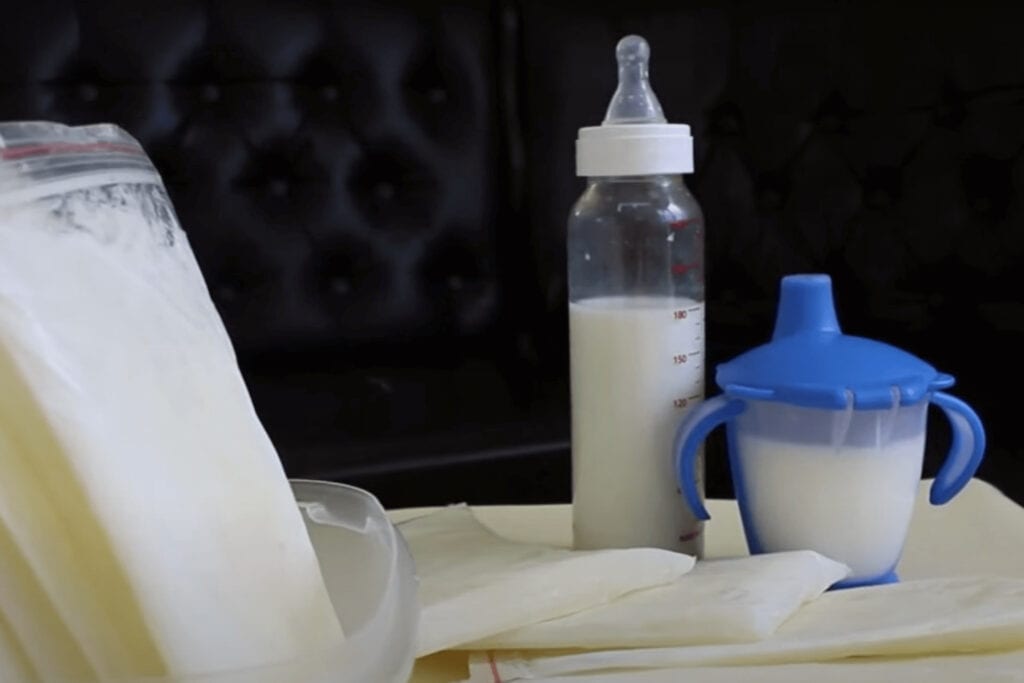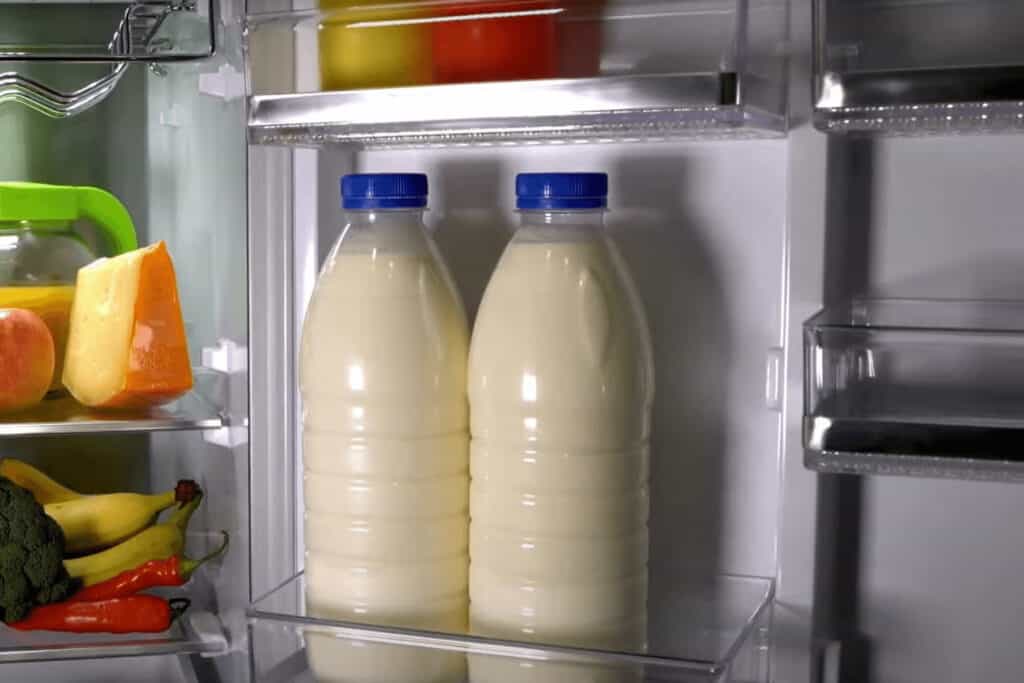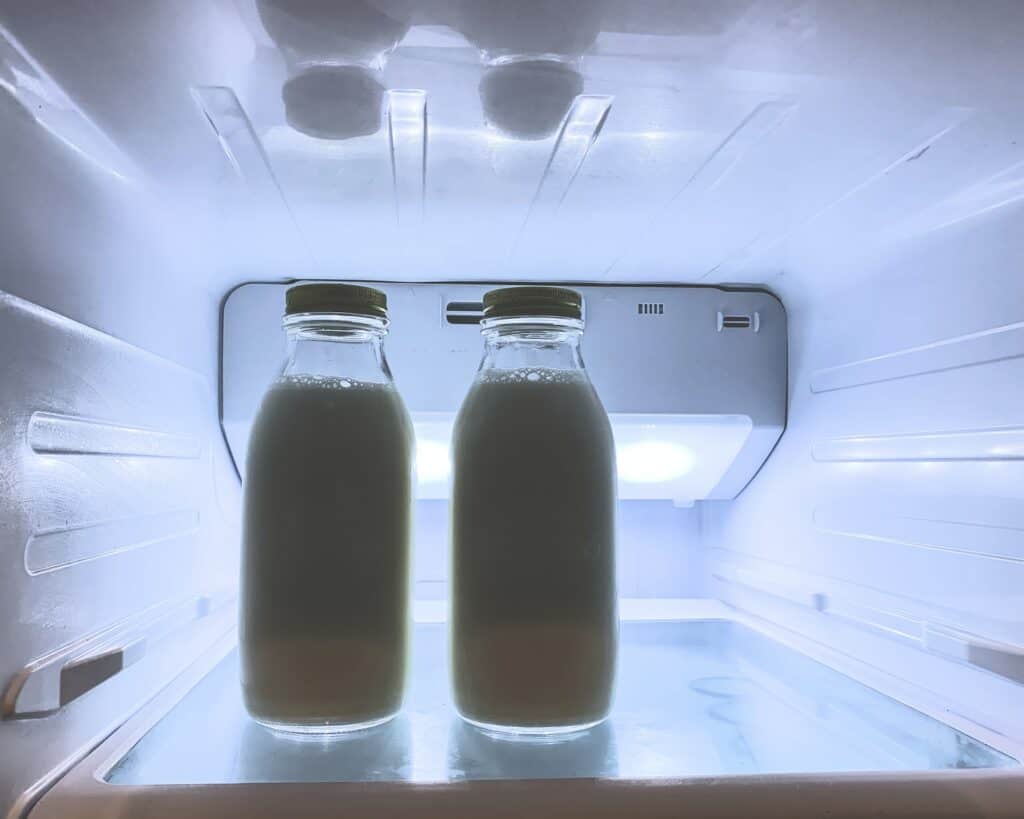Breastfeeding is a personal and intimate experience between a mother and her child. However, returning to work after maternity leave can be a challenging time for breastfeeding moms. One of the biggest concerns for working moms who breastfeed is how to maintain their milk supply while away from their baby. Storing breastmilk is an essential part of this process, but how much milk should a mom store before returning to work?
Understanding Breastmilk Storage is crucial for working moms who want to continue breastfeeding. Proper storage ensures that breastmilk maintains its nutritional value and is safe for the baby to consume. The amount of milk a mom should store depends on several factors, such as how often her baby feeds, how long she will be away from her baby, and how much milk her baby consumes per feeding. Planning Your Breastmilk Stash Before Returning to Work can help a mom determine how much milk she needs to store and how often she needs to pump.
Key Takeaways
- Proper breastmilk storage is crucial for working moms who want to continue breastfeeding.
- Planning the breastmilk stash before returning to work can help a mom determine how much milk she needs to store and how often she needs to pump.
- Consulting with a lactation expert can provide a mom with additional guidance and support.
Understanding Breastmilk Storage
Breastmilk storage is an essential aspect of breastfeeding, especially for working mothers who need to store milk for their babies while they are away. Proper storage of breastmilk ensures that the milk remains safe and nutritious for the baby to consume.
The amount of breastmilk that a mother should store before returning to work depends on several factors, including the baby’s age, feeding schedule, and the number of hours the mother will be away. Typically, a newborn baby will consume around 1.5 to 3 ounces of milk per feeding, while an older baby may need around 3 to 4 ounces per feeding.
Breast milk storage guidelines recommend storing milk in a clean, sterilized container or plastic bags designed for breastmilk storage. Containers should be labeled with the date and time the milk was expressed to ensure that the oldest milk is used first.
Breastmilk can be stored in the refrigerator for up to four days at a temperature of 39°F or lower. Frozen breastmilk can be stored for up to six months in a standard freezer at a temperature of 0°F or lower.
When freezing breastmilk, it is essential to leave some room at the top of the container or bag to allow for expansion. It is also important to use containers that are leak-proof and have a tight seal to prevent contamination.
When defrosting frozen breastmilk, it is best to thaw it in the refrigerator overnight. Alternatively, the milk can be placed in a bowl of warm water or held under running warm water until it reaches room temperature. It is not recommended to defrost breastmilk in the microwave, as it can destroy some of the milk’s beneficial properties and create hot spots that can burn the baby’s mouth.
In summary, understanding breastmilk storage is crucial for working mothers who need to store milk for their babies. Proper storage techniques, including using clean containers, labeling, and following recommended storage times and temperatures, can help ensure that the milk remains safe and nutritious for the baby to consume.
Planning Your Breastmilk Stash Before Returning to Work
Returning to work after maternity leave can be overwhelming for new mothers who are breastfeeding. One of the biggest concerns is how much breastmilk to store before returning to work. Planning ahead can help alleviate some of the stress and ensure that there is enough milk for the baby while the mother is away.

The amount of milk a baby needs varies depending on age, weight, and feeding frequency. On average, a newborn will consume 1-2 ounces of milk per feeding, while an older baby may consume 3-4 ounces. It is recommended to store enough milk for at least one day’s worth of feedings, which is typically around 25-30 ounces.
To determine how much milk to store, mothers should consider their work schedule and how many feedings the baby will need during that time. It is also important to factor in time for pumping at work and any additional milk that may be needed for growth spurts or unexpected circumstances.
Mothers can begin building their breastmilk stash while on maternity leave by pumping after feedings or during times when the baby is sleeping. It is recommended to store milk in 2-4 ounce portions to avoid waste and to label each bag with the date and amount of milk.
In addition to storing milk, mothers should also consider the best way to transport and store the milk while at work. A small cooler with ice packs can keep the milk fresh for several hours, and a refrigerator or freezer may be available for longer storage.
Overall, planning ahead and building a breastmilk stash before returning to work can help ease the transition and ensure that the baby is well-fed while the mother is away.
Comfort and Support for Breastfeeding Employee
Returning to work after giving birth can be a daunting experience for many new mothers. One of the biggest concerns is how to continue breastfeeding while working outside the home. Fortunately, there are a number of ways that employers can support their breastfeeding employees and make the transition back to work as smooth as possible.
One of the most important things employers can do is provide a comfortable and private space for breastfeeding or pumping. This can be a dedicated lactation room, or simply a private office or conference room that can be used for this purpose. The room should be clean, well-lit, and equipped with a comfortable chair, a table or desk, and an electrical outlet for the breast pump.
Employers should also provide breastfeeding employees with adequate break time to pump milk. The Affordable Care Act requires employers to provide “reasonable break time” and a private space for breastfeeding employees to pump milk for up to one year after the birth of their child. This time should be paid, and employers should work with their employees to schedule breaks that work for everyone.
In addition to providing a comfortable space and adequate break time, employers can also offer other forms of support. This might include access to a lactation consultant, breast pump rental or purchase programs, and educational materials about breastfeeding and pumping. Employers can also encourage a supportive workplace culture by educating other employees about the importance of breastfeeding and creating a supportive environment for breastfeeding employees.
It’s important to note that there are laws in place to protect the rights of breastfeeding employees. The Affordable Care Act requires employers to provide reasonable break time and a private space for breastfeeding employees to pump milk. Some states and municipalities have additional laws that provide further protections for breastfeeding employees. Employers should familiarize themselves with these laws and ensure that they are in compliance.
Overall, providing support and accommodations for breastfeeding employees is not only the right thing to do, it’s also good for business. Breastfeeding has been shown to improve infant health, reduce healthcare costs, and increase employee retention and productivity. By supporting breastfeeding employees, employers can create a more healthy and productive workplace for everyone.
Optimizing Your Pumping Schedule
When it comes to returning to work while continuing to breastfeed, it’s important to have a plan in place for pumping and storing breastmilk. Optimizing your pumping schedule can help ensure that you have enough milk to provide for your baby while you’re away.

One key factor in optimizing your pumping schedule is finding the right breast pump. There are many different types of breast pumps available, from manual pumps to electric pumps with various settings. It’s important to choose a pump that is comfortable and efficient for you to use.
Another important aspect of optimizing your pumping schedule is taking advantage of break time at work. Many employers are required by law to provide break time for nursing mothers to express milk. It’s important to communicate with your employer about your needs and to plan ahead for break times.
In addition to finding the right breast pump and taking advantage of break time, there are other strategies you can use to optimize your pumping schedule. These include:
- Pumping frequently, ideally every 2-3 hours, to maintain milk supply
- Pumping for at least 15-20 minutes each session to ensure that the breast is fully emptied
- Storing breastmilk in small quantities, such as 2-4 ounces, to reduce waste and ensure freshness
- Labeling breastmilk with the date and time it was expressed to keep track of freshness
- Storing breastmilk in a refrigerator or freezer with a consistent temperature to maintain quality
By optimizing your pumping schedule and following these strategies, you can ensure that you have enough breastmilk stored for your baby while you’re away at work.
Choosing and Preparing Your Child Care Provider
When returning to work after having a baby, choosing a reliable and trustworthy child care provider is crucial. The caregiver must be able to provide a safe and nurturing environment for the baby while the mother is away.
There are various options for child care, including in-home care, family daycare, and center-based care. Each option has its advantages and disadvantages, and the mother should choose the one that best suits her needs and preferences.
Before choosing a child care provider, the mother should conduct thorough research and ask for recommendations from friends and family. She should also visit the facility and meet with the caregiver to assess the environment and ensure that it meets her standards.
Once a child care provider is chosen, the mother should prepare her baby for the transition. She should gradually introduce the baby to the caregiver and the new environment. The mother should also provide the caregiver with detailed information about the baby’s routine, feeding schedule, and any special needs.
In summary, choosing and preparing a child care provider requires careful consideration and planning. The mother should choose a provider that she trusts and feels comfortable with and prepare her baby for the transition to the new environment.
Maintaining Nutrition and Breastfeeding Goals
Returning to work after having a baby can be a challenging time for new mothers, especially when it comes to maintaining their breastfeeding goals. One of the most common concerns is how much breastmilk to store before returning to work. It’s important to make sure that the baby is getting enough nutrition while the mother is away, and that the mother’s milk supply is maintained.

To maintain breastfeeding goals and ensure that the baby is getting enough nutrition, it’s recommended to store at least one to two day’s worth of breastmilk before returning to work. This will provide enough milk for the baby while the mother is away, and also allow for some extra milk to be stored in case of emergencies.
It’s important to note that breastmilk storage guidelines vary depending on the age and feeding habits of the baby. For example, a newborn may require more milk than an older baby who is also eating solid foods. It’s recommended to consult with a healthcare provider or lactation consultant to determine the appropriate amount of milk to store for each individual baby.
In addition to storing enough milk, it’s important to maintain a healthy diet and stay hydrated to ensure a healthy milk supply. This includes eating a balanced diet with plenty of fruits, vegetables, and protein, and drinking plenty of water throughout the day.
Overall, maintaining breastfeeding goals and ensuring proper nutrition for the baby while returning to work can be achieved through proper breastmilk storage and maintaining a healthy diet and hydration.
Consulting with a Lactation Expert
For mothers who are planning to return to work but want to continue breastfeeding, it is essential to consult with a lactation expert. Lactation consultants are skilled professionals who can provide valuable advice and support to help mothers achieve their breastfeeding goals.
A lactation consultant can help a mother determine how much breast milk she needs to store before returning to work. They can also provide guidance on how to properly store and thaw breast milk and how to maintain a healthy milk supply. A lactation consultant can also offer advice on how to manage breastfeeding and pumping while at work, including how to handle any challenges that may arise.
Mothers who are eligible for the Women, Infants, and Children (WIC) program may also be able to receive support from a lactation consultant. WIC provides breastfeeding support services, including access to lactation consultants, breast pumps, and breastfeeding education.
Overall, consulting with a lactation expert can be a valuable resource for mothers who want to continue breastfeeding while returning to work. By working with a lactation consultant, mothers can gain the knowledge and confidence they need to successfully manage breastfeeding and pumping while maintaining a healthy milk supply.
Storing and Transporting Breastmilk
Storing breastmilk is an important part of the breastfeeding process, especially for mothers who are returning to work. Proper storage and transportation of breastmilk can ensure that the milk remains safe and nutritious for the baby.

One of the most important things to consider when storing breastmilk is the temperature. Breastmilk should be stored in a clean, sealed container in the refrigerator or freezer. It is important to label the container with the date and time that the milk was expressed, as well as the amount of milk in the container.
When transporting breastmilk, it is important to keep it at the proper temperature. An insulated cooler with ice packs can help keep the milk at a safe temperature during transport. It is also important to avoid exposing the milk to direct sunlight or extreme temperatures.
Milk storage guidelines vary depending on the age of the baby and how the milk will be used. As a general rule, breastmilk can be stored in the refrigerator for up to four days and in the freezer for up to six months. However, it is important to follow specific guidelines for storing and using breastmilk to ensure that it remains safe and nutritious for the baby.
Overall, proper storage and transportation of breastmilk is essential for maintaining the health and well-being of both the mother and the baby. By following guidelines for storing and using breastmilk, mothers can ensure that their babies receive the best possible nutrition even when they are away from home.
Cleaning and Supplies
In order to ensure that breastmilk storage is safe and effective, it is important to have the right cleaning supplies on hand. Breast pump parts, bottles, and storage containers should be washed in hot, soapy water and allowed to air dry before use. It is also important to clean and sanitize these items regularly, especially if they are being used on a daily basis.
For cleaning breast pump parts, it is recommended to use a dedicated brush and soap that is specifically designed for this purpose. Many breast pump manufacturers also offer cleaning wipes that can be used to quickly clean pump parts when on the go.
When it comes to breastmilk storage supplies, it is important to choose containers that are safe for storing breastmilk. Containers should be made of BPA-free materials and should be designed for use with breastmilk. It is also important to choose containers that are the right size for the amount of milk that will be stored.
In addition to storage containers, it is also helpful to have labels and markers on hand for labeling milk with the date and time it was expressed. This can help ensure that the oldest milk is used first and can also help prevent waste.
Overall, having the right cleaning supplies and storage containers can help make breastmilk storage safe and easy for working mothers. By taking the time to properly clean and store breastmilk, mothers can ensure that their babies are receiving the best possible nutrition even when they are away at work.
Understanding Milk Quantity
Breastfeeding mothers who are planning to return to work often wonder how much breastmilk they should store before leaving their baby. The answer varies depending on several factors, including the baby’s age, feeding habits, and the number of hours the mother will be away from the baby.

On average, a baby needs about 1-1.5 ounces of breastmilk per hour when the mother is away. For example, if the mother will be gone for 8 hours, the baby will need 8-12 ounces of breastmilk during that time. It’s important to note that some babies may need more or less milk depending on their individual needs.
Mothers should also consider how many feedings the baby will have while she is away. If the baby typically feeds every 2-3 hours, the mother should aim to provide enough milk for 2-3 feedings. For example, if the baby feeds every 3 hours and the mother will be gone for 9 hours, she should provide enough milk for 3 feedings, or 12-18 ounces.
It’s also important to consider how much milk the mother can pump during a typical pumping session. On average, a mother can expect to pump about 1-2 ounces of milk per breast per pumping session. This means that if the baby needs 12 ounces of milk while the mother is away, she will need to pump at least 6 times to provide enough milk.
Mothers should keep in mind that breastmilk storage guidelines recommend storing milk in 2-4 ounce portions to reduce waste. It’s also important to label milk with the date it was pumped to ensure that the oldest milk is used first.
Overall, understanding milk quantity is an important aspect of preparing to return to work while continuing to breastfeed. By considering the baby’s needs, feeding habits, and the mother’s pumping abilities, mothers can ensure that they have enough milk stored to provide for their baby while they are away.
Related Posts:
Frequently Asked Questions
How much breast milk should I store before returning to work?
The amount of breast milk to store before returning to work varies depending on how much milk your baby consumes daily, how many hours you will be away from your baby, and how often you plan to pump at work. A general guideline is to store 1-1.5 ounces of breast milk for every hour you will be away from your baby.
How do I calculate my breast milk stash?
To calculate your breast milk stash, you need to know how much milk your baby consumes per feeding and how many feedings your baby will have while you are away. Multiply the amount of milk per feeding by the number of feedings, and then multiply that number by the number of hours you will be away from your baby.
What is a breast milk stash calculator and how do I use it?
A breast milk stash calculator is a tool that helps you calculate how much breast milk you need to store before returning to work. You can find several online calculators that allow you to input your baby’s age, weight, and feeding schedule to determine how much milk you should store. To use a breast milk stash calculator, simply input the required information and follow the instructions.
Is there a recommended amount of breast milk to pump before going back to work?
There is no specific recommended amount of breast milk to pump before going back to work. However, it is important to have a sufficient amount of milk stored to ensure that your baby is well-fed while you are away. A good rule of thumb is to have at least a few days’ worth of milk stored before returning to work.
What are the best ways to build a breast milk stash while exclusively pumping?
The best ways to build a breast milk stash while exclusively pumping are to pump frequently, pump after feedings, and pump during the night. It is also important to stay hydrated and well-nourished to maintain a healthy milk supply.
How can I prepare my milk supply before returning to work?
To prepare your milk supply before returning to work, you can start pumping and storing milk a few weeks before your return date. You can also try power pumping, which involves pumping for short periods of time with short breaks in between to stimulate milk production. Additionally, you can try adding galactagogues, such as fenugreek or lactation cookies, to your diet to boost milk supply.

Iesha is a loving mother of 2 beautiful children. She’s an active parent who enjoys indoor and outdoor adventures with her family. Her mission is to share practical and realistic parenting advice to help the parenting community becoming stronger.
